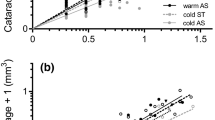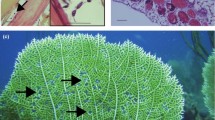Abstract
Interactions between environmental stressors play an important role in shaping the health of an organism. This is particularly true in terms of the prevalence and severity of infectious disease, as stressors in combination will not always act to simply decrease the immune function of a host, but may instead interact to compound or even oppose the influence of parasitism on the health of an organism. Here, we explore the impact of environmental stress on host–parasite interactions using the water flea Daphnia magna and it is obligate parasite Pasteuria ramosa. Utilising an ecologically relevant stressor, we focus on the combined effect of salinity and P. ramosa on the fecundity and survival of the host, as well as on patterns of infectivity and the proliferation of the parasite. We show that in the absence of the parasite, host fecundity and survival was highest in the low salinity treatments. Once a parasite was introduced into the environment, however, salinity and parasitism acted antagonistically to influence both host survival and fecundity, and these patterns of disease were unrelated to infection rates or parasite spore loads. By summarising the form of interactions found in the broader Daphnia literature, we highlight how the combined effect of stress and parasitism will vary with the type of stressor, the trait used to describe the health of Daphnia and the host–parasite combination under observation. Our results highlight how the context-dependent nature of interactions between stress and parasitism inevitably complicates the link between environmental factors and the prevalence and severity of disease.



Similar content being viewed by others
References
Allen DE, Little TJ (2010) Identifying energy constraints to parasite resistance. J Evol Biol 21:224–229
Arnér M, Koivisto S (1993) Effects of salinity on metabolism and life history characteristics of Daphnia magna. Hydrobiologia 259:69–77
Baillieul M, De Wachter B, Blust R (1998) Effect of salinity on the swimming velocity of the water flea Daphnia magna. Physiol Zool 71:703–707
Ben-Ami F, Ebert D, Regoes RR (2010) Pathogen dose infectivity curves as a method to analyze the distribution of host susceptibility: a quantitative assessment of maternal effects after food stress and pathogen exposure. Am Nat 175:106–115
Bittner K, Rothhaupt K-O, Ebert D (2002) Ecological interactions of the microparasite Caullerya mesnili and its host Daphnia galeata. Limnol Oceanogr 47:300–305
Brett JR (1958) Implications and assessment of environmental stress. In: Larkin PA (ed) The investigation of fish-power problems. University of British Columbia, Vancouver, pp 69–83
Brooks SJ, Mills CL (2011) Parasitic infection manipulates sodium regulation in the freshwater amphipod Gammarus pulex (L.). Comp Biochem Physiol A Mol Integr Physiol 159:247–252
Coors A, De Meester L (2008) Synergistic, antagonistic and additive effects of multiple stressors: predation threat, parasitism and pesticide exposure in Daphnia magna. J Appl Ecol 45:1820–1828
Coors A, De Meester L (2011) Fitness and virulence of a bacterial endoparasite in an environmentally stressed crustacean host. Parasitology 138:122–131
Coors A, Decaestecker E, Jansen M, De Meester L (2008) Pesticide exposure strongly enhances parasite virulence in an invertebrate host model. Oikos 117:1840–1846
Dunn AM, Hatcher MJ (1997) The effect of salinity on transovarial transmission of a microsporidian infecting Gammarus duebeni. Parasitology 115:381–385
Eads BD, Andrews J, Colbourne JK (2008) Ecological genomics in Daphnia: stress responses and environmental sex determination. Heredity 100:184–190
Ebert D (2005) Ecology, epidemiology, and evolution of parasitism in Daphnia. Available at: http://www.ncbi.nlm.nih.gov/entrez/query.fcgi?db=Books. National Library of Medicine (U.S.), National Center for Biotechnology Information, Bethesda
Ebert D (2008) Host-parasite coevolution: insights from the Daphnia–parasite model system. Curr Opin Microbiol 11:290–301
Ebert D, Zschokke-Rohringer CD, Carius HJ (1998) Within-and between-population variation for resistance of Daphnia magna to the bacterial endoparasite Pasteuria ramosa. Proc R Soc Lond B 265:2127–2134
Ebert D, Carius HJ, Little T, Decaestecker E (2004) The evolution of virulence when parasites cause host castration and gigantism. Am Nat 164[Suppl]:S19–S32
Esch GW, Gibbons JW, Bourque JE (1975) An analysis of the relationship between stress and parasitism. Am Midl Nat 93:339–353
Flatt T, Heyland A (2011) Mechanisms of life history evolution: the genetics and physiology of life history traits and trade-offs. Oxford University Press, Oxford
Fox J, Weisberg S (2011) An R companion to applied regression. Sage, Thousand Oaks
Frost PC, Ebert D, Smith VH (2008) Responses of a bacterial pathogen to phosphorus limitation of its aquatic invertebrate host. Ecology 89:313–318
Glaser R, Rabin B, Chesney M, Cohen S, Natelson B (1999) Stress-induced immunomodulation: implications for infectious diseases? JAMA 281:2268–2270
Gonçalves AMM, Castro BB, Pardal MA, Gonçalves F (2007) Salinity effects on survival and life history of two freshwater cladocerans (Daphnia magna and Daphnia longispina). Ann Limnol—Int J Lim 43:13–20
Hall MD, Ebert D (2012) Disentangling the influence of parasite genotype, host genotype and maternal environment on different stages of bacterial infection in Daphnia magna. Proc R Soc Lond B 279:3176–3183
Hawlena D, Schmitz OJ (2010) Physiological stress as a fundamental mechanism linking predation to ecosystem functioning. Am Nat 176:537–556
Heine-Fuster I, Vega-Retter C, Sabat P, Ramos-Jiliberto R (2010) Osmoregulatory and demographic responses to salinity of the exotic cladoceran Daphnia exilis. J Plankton Res 32:1405–1411
Hoffmann AA, Parsons PA (1991) Evolutionary genetics and environmental stress. Oxford University Press, Oxford
Hofmann GE, Todgham AE (2010) Living in the now: physiological mechanisms to tolerate a rapidly changing environment. Annu Rev Physiol 72:127–145
Khansari DN, Murgo AJ, Faith RE (1990) Effects of stress on the immune system. Immunol Today 11:170–175
Klüttgen B, Dülmer U, Engels M, Ratte HT (1994) ADaM, an artificial freshwater for the culture of zooplankton. Water Res 28:743–746
Koprivnikar J, Poulin R (2009) Effects of temperature, salinity, and water level on the emergence of marine cercariae. Parasitol Res 105:957–965
Krist AC, Jokela J, Wiehn J, Lively CM (2004) Effects of host condition on susceptibility to infection, parasite developmental rate, and parasite transmission in a snail–trematode interaction. J Evol Biol 17:33–40
Lafferty KD, Holt RD (2003) How should environmental stress affect the population dynamics of disease? Ecol Lett 6:654–664
Lass S, Bittner K (2002) Facing multiple enemies: parasitised hosts respond to predator kairomones. Oecologia 132:344–349
Le Moullac G, Soyez C, Saulnier D, Ansquer D, Avarre JC, Levy P (1998) Effect of hypoxic stress on the immune response and the resistance to vibriosis of the shrimp Penaeus stylirostris. Fish Shellfish Immunol 8:621–629
Lei F, Poulin R (2011) Effects of salinity on multiplication and transmission of an intertidal trematode parasite. Mar Biol 158:995–1003
Luijckx P, Ben-Ami F, Mouton L, Du Pasquier L, Ebert D (2010) Cloning of the unculturable parasite Pasteuria ramosa and its Daphnia host reveals extreme genotype–genotype interactions. Ecol Lett 14:125–131
Malham SK, Lacoste A, Gélébart F, Cueff A, Poulet SA (2003) Evidence for a direct link between stress and immunity in the mollusc Haliotis tuberculata. J Exp Zool 295A:136–144
Marcogliese DJ, Pietrock M (2011) Combined effects of parasites and contaminants on animal health: parasites do matter. Trends Parasitol 27:123–130
Martínez-Jerónimo F, Martínez-Jerónimo L (2007) Chronic effect of NaCl salinity on a freshwater strain of Daphnia magna Straus (Crustacea: cladocera): a demographic study. Ecotoxicol Environ Saf 67:411–416
Mitchell SE, Rogers ES, Little TJ, Read AF (2005) Host-parasite and genotype-by-environment interactions: temperature modifies potential for selection by a sterilizing pathogen. Evolution 59:70–80
Piscart C, Webb D, Beisel JN (2007) An acanthocephalan parasite increases the salinity tolerance of the freshwater amphipod Gammarus roeseli (Crustacea: gammaridae). Naturwissenschaften 94:741–747
Pulkkinen K, Ebert D (2004) Host starvation decreases parasite load and mean host size in experimental populations. Ecology 85:823–833
Ranta E (1979) Niche of Daphnia species in rock pools. Arch Hydrobiol 87:205–223
Reisser CE, Forward RB (1991) Effect of salinity on osmoregulation and survival of a rhizocephalan parasite, Loxothylacus panopaei, and its crab host, Rhithropanopeus harrisii. Estuaries 14:102–106
Restif O, Kaltz O (2006) Condition-dependent virulence in a horizontally and vertically transmitted bacterial parasite. Oikos 114:148–158
Schmid-Hempel P (2003) Variation in immune defence as a question of evolutionary ecology. Proc R Soc Lond B 270:357–366
Schmid-Hempel P (2011) Evolutionary parasitology: the integrated study of infections, immunology, ecology, and genetics. Oxford University Press, Oxford
Selye H (1950) Stress and the general adaptation syndrome. Br Med J 1:1383–1392
Seppälä O, Liljeroos K, Karvonen A, Jokela J (2008) Host condition as a constraint for parasite reproduction. Oikos 117:749–753
Sousa WP, Gleason M (1989) Does parasitic infection compromise host survival under extreme environmental conditions? The case for Cerithidea californica (Gastropoda: prosobranchia). Oecologia 80:456–464
Stjernman M, Little TJ (2011) Genetic variation for maternal effects on parasite susceptibility. J Evol Biol 24:2357–2363
Studer A, Poulin R (2012) Effects of salinity on an intertidal host–parasite system: is the parasite more sensitive than its host? J Exp Mar Biol Ecol 412:110–116
Vale PF, Little TJ (2009) Measuring parasite fitness under genetic and thermal variation. Heredity 103:102–109
Vale PF, Stjernman M, Little TJ (2008) Temperature-dependent costs of parasitism and maintenance of polymorphism under genotype-by-environment interactions. J Evol Biol 21:1418–1427
Yin M, Laforsch C, Lohr JN, Wolinska J (2011) Predator-induced defense makes Daphnia more vulnerable to parasites. Evolution 65:1482–1488
Zuk M, Stoehr AM (2002) Immune defense and host life history. Am Nat 160:S9–S22
Acknowledgments
This study was supported by an EU Marie Curie Incoming International Fellowship (PIIF-GA-2009-252417) to MDH and by the Swiss National Science Foundation. We thank David J. Marcogliese, two anonymous reviewers and members of the Ebert Group for comments on the manuscipt, and J. Hottinger and U. Stiefel for laboratory assistance. All experiments complied with the current laws of Switzerland.
Author information
Authors and Affiliations
Corresponding author
Additional information
Communicated by David Marcogliese.
Rights and permissions
About this article
Cite this article
Hall, M.D., Vettiger, A. & Ebert, D. Interactions between environmental stressors: the influence of salinity on host–parasite interactions between Daphnia magna and Pasteuria ramosa . Oecologia 171, 789–796 (2013). https://doi.org/10.1007/s00442-012-2452-3
Received:
Accepted:
Published:
Issue Date:
DOI: https://doi.org/10.1007/s00442-012-2452-3




